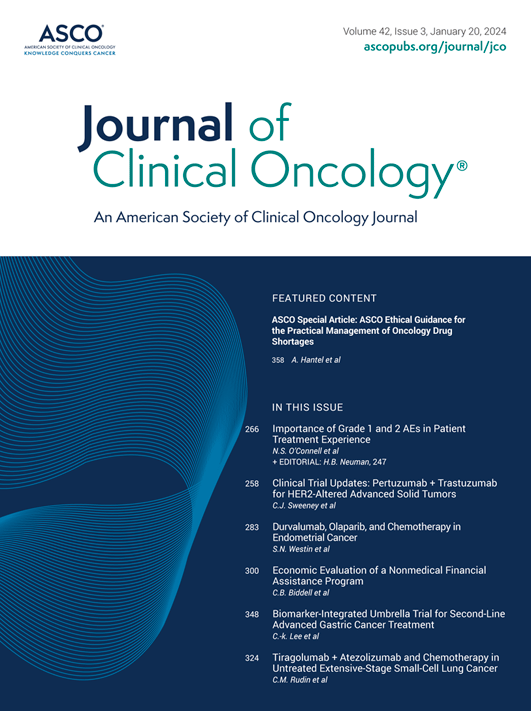Ruxolitinib in Patients With Corticosteroid-Refractory or Corticosteroid-Dependent Chronic Graft-Versus-Host Disease: 3-Year Final Analysis of the Phase III REACH3 Study.
IF 42.1
1区 医学
Q1 ONCOLOGY
引用次数: 0
Abstract
In REACH3 (ClinicalTrials.gov identifier: NCT03112603), ruxolitinib was investigated versus best available therapy (BAT) for 3 years in patients with steroid-refractory/dependent chronic graft-versus-host-disease (SR/D-cGVHD). Patients received ruxolitinib (10 mg twice daily) or BAT for 24 weeks; thereafter (weeks 24-156), patients continued randomized treatment, entered long-term survival follow-up, or crossed over from BAT to ruxolitinib. In 329 randomly assigned patients (ruxolitinib: 165; BAT: 164), the median failure-free survival (FFS) was 38.4 months for ruxolitinib versus 5.7 months for BAT (hazard ratio, 0.36 [95% CI, 0.27 to 0.49]). Median duration of response (DOR) was not reached for ruxolitinib versus 6.4 months for BAT. Ruxolitinib-treated patients had a higher probability of FFS (ruxolitinib: 56.5%; BAT: 18.2%) and maintaining a response (ruxolitinib: 59.6%; BAT: 26.7%) at 36 months. Median overall survival was not reached. Nonrelapse mortality and malignancy relapse/recurrence events were low. In 70 patients who crossed over to ruxolitinib, the overall response rate (50.0%) at week 24 and best overall response (81.4%) during the crossover period were consistent with the primary analysis of randomly assigned patients. No new safety signals were observed. Ruxolitinib provided longer FFS and DOR than BAT, demonstrating sustained efficacy and manageable safety over 3 years of follow-up in patients with SR/D-cGVHD.Ruxolitinib用于皮质类固醇难治性或皮质类固醇依赖性慢性移植物抗宿主病患者:III期REACH3研究的3年最终分析
在REACH3 (ClinicalTrials.gov identifier: NCT03112603)中,研究了ruxolitinib与最佳可用疗法(BAT)对类固醇难治性/依赖性慢性移植物抗宿主病(SR/D-cGVHD)患者的3年疗效。患者接受ruxolitinib (10 mg,每日2次)或BAT治疗24周;此后(第24-156周),患者继续随机治疗,进入长期生存随访,或从BAT过渡到ruxolitinib。在329例随机分配的患者中(ruxolitinib: 165;BAT: 164),鲁索利替尼的中位无衰竭生存期(FFS)为38.4个月,BAT为5.7个月(风险比为0.36 [95% CI, 0.27至0.49])。鲁索利替尼的中位反应持续时间(DOR)未达到,而BAT为6.4个月。ruxolitinib治疗的患者发生FFS的概率更高(ruxolitinib: 56.5%;BAT: 18.2%)和维持缓解(ruxolitinib: 59.6%;BAT: 26.7%), 36个月。中位总生存期未达到。非复发死亡率和恶性复发/复发事件较低。在70例交叉使用ruxolitinib的患者中,第24周的总缓解率(50.0%)和交叉期间的最佳总缓解率(81.4%)与随机分配患者的初步分析一致。没有观察到新的安全信号。Ruxolitinib提供比BAT更长的FFS和DOR,在SR/D-cGVHD患者的3年随访中显示出持续的疗效和可管理的安全性。
本文章由计算机程序翻译,如有差异,请以英文原文为准。
求助全文
约1分钟内获得全文
求助全文
来源期刊

Journal of Clinical Oncology
医学-肿瘤学
CiteScore
41.20
自引率
2.20%
发文量
8215
审稿时长
2 months
期刊介绍:
The Journal of Clinical Oncology serves its readers as the single most credible, authoritative resource for disseminating significant clinical oncology research. In print and in electronic format, JCO strives to publish the highest quality articles dedicated to clinical research. Original Reports remain the focus of JCO, but this scientific communication is enhanced by appropriately selected Editorials, Commentaries, Reviews, and other work that relate to the care of patients with cancer.
 求助内容:
求助内容: 应助结果提醒方式:
应助结果提醒方式:


